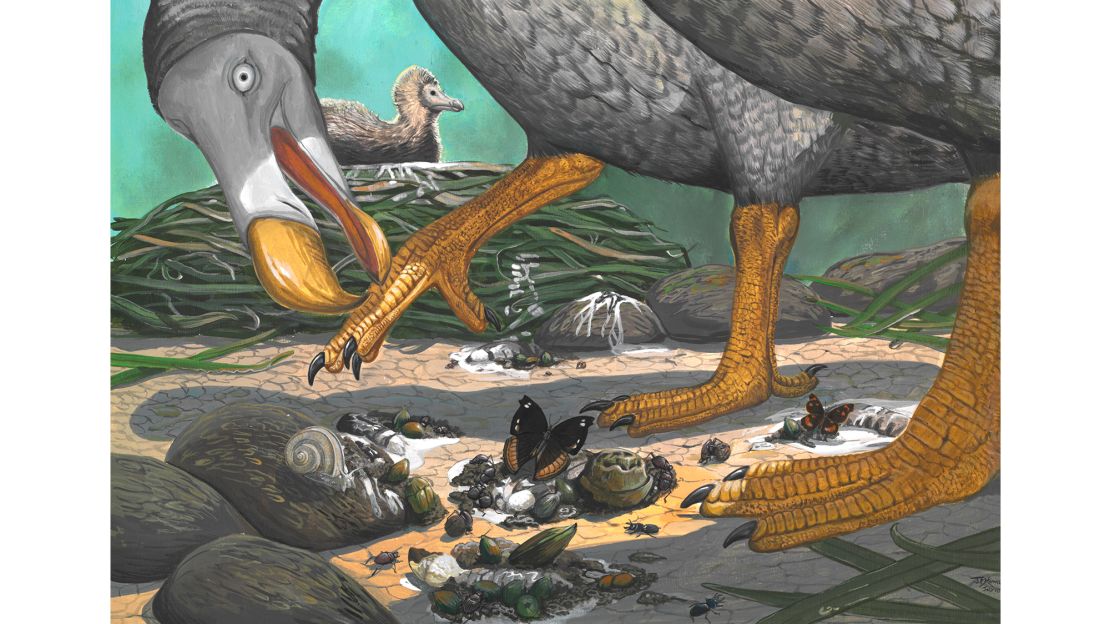Story highlights
A new analysis of dodo bones reveals the birds adapted their life cycles to their environment
The analysis was matched against centuries-old accounts by Dutch sailors
A new analysis of 22 dodo bones paints a picture of how the flightless bird that went extinct around the end of the 17th century may have lived.
Dutch sailors recorded the first observations of dodos in 1598, when they saw the large, strange birds on Mauritius, a tiny island east of Madagascar in the Indian Ocean. Their accounts suggest sailors hunted dodos for their tasty meat. The introduction of invasive species drove the birds to extinction between 1662 and 1693, other studies have shown.

Over the years, researchers have studied dodo bones to classify them and to learn more about their skeletal anatomy. But the ecology of the dodo – how it related to others and its environment – has proven more difficult to nail down. Dodos’ closest living relatives today are doves and pigeons, which can be tough to compare with a long-extinct, 22-pound bird.
So, a team of researchers combined the sailor’s historical accounts with previous insights from the bones of the bird.
“For the first time, we have a lot more information about the ecology of the dodo,” Delphine Angst, of the Palaeobiology Research Group at the University of Cape Town in South Africa, said by email. Angst led the study published Thursday in the journal Scientific Reports.
“Usually, as a paleontologist, we only have the bones to workwith and to propose some hypotheses about the ecology of the extinct animal,” Angst said. “But in the case of the dodo, because this bird was contemporaneous with humans recently, we have several old documentswritten by the sailors who saw this bird alive.”
How the dodos lived
While the beautiful island nation may seem like an ideal place to settle, its tendency for harsh weather had a big influence over how the dodos lived, the study found. Between November and March, cyclones, heavy rain and strong winds would strip vegetation of leaves, flowers and fruit, prompting food shortages. The dodos would essentially have “fat” and “thin” periods.

In response to their environment, dodos would breed in August, after enjoying the plethora of food during the “fat” season. After chicks hatched, they would rapidly grow to almost the size of an adult and reach sexual maturity within two to four months, before the cyclones began. This gave them a better chance of surviving the island’s deprived resources during the “thin” season, scientists found.
The researchers also aimed to discover why descriptive accounts from sailors differed so much. Some claimed the dodos had a few dark quills where wings should have been and tails made up of small, curled gray plumes. Others wrote that the dodos had no feathers, only downy feathers or were simply covered in down.
By studying their bones, researchers realized sailors were witnessing dodos at different points in their molting cycle. In March, their wings and tail feathers would be replaced, and by the end of July, all their feathers would be replaced – just in time for breeding season.
Bone histology, or the study of the microscopic structure of tissues within the bones, revealed this detail, according to the report.
“Before our work, very few things were known, and now, we can separate the juveniles to the adults, the females to the males,” Angst said. “We found some ovulating females which permits us to study the reproduction of this enigmatic bird, and we observed some traces of molting.”
While the new insights help fill a gap in knowledge about the extinct bird, they also inspire researchers like Angst to keep studying the bones.
“For the first time, we have some evidence of the reproduction and the molting, but on top of that, we can say when these events happen(ed) during the year,” she said. “Our results show that there is still a lot of things which have to be discovered about the dodo.”


































































































































































